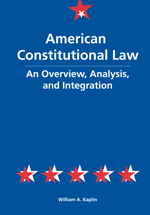American Constitutional Law
An Overview, Analysis, and Integration
2004
Tags: Constitutional Law, First Year, Political Science
Teacher's Manual available
520 pp $48.00
ISBN 978-0-89089-084-4
The preface and introduction to the Teacher's Manual are available by clicking here.
The 2012 Update is available by clicking here.
Conveniently divided into fifteen chapters with numerous subsections, this book presents a clear, comprehensive, and integrated introduction to the U.S. Constitution and American constitutional law. Kaplin develops the basic concepts, conceptual distinctions, and first principles that provide the foundation for constitutional law; the process by which the Constitution is interpreted; and the analytical methodologies by which individual clauses are applied to new circumstances. Leading U.S. Supreme Court cases, especially the classical cases, are also presented and analyzed throughout.
The author periodically uses history, political science, and jurisprudence to enhance the reader's understanding of the subject, including a section on constitutionalism from the early Greek philosophers to the present; historical timelines of Supreme Court case developments; and expositions of the American concepts of federalism and separation of powers. Several sections also discuss the inter-relationship between the federal Constitution and state constitutions.
This book contains substantial study guidance for students in law school courses or law-related graduate school courses, and readers who are engaged in independent learning apart from any formal course. There are learning exercises at many points in the book, for instance, followed by answer guidelines. There is also a section on study suggestions at the end of each substantive chapter; a methodology for reading and analyzing cases; guidance on study techniques and exam taking; and bibliographies to guide further reading.
The teacher's manual includes numerous realistic problems with review guidelines that the instructor may distribute to students, as well as various "analytical frameworks" that the instructor can use to guide student analysis of particular types of problems and various graphics that illustrate key concepts. The manual is also set up so that it provides instructors guidance and materials that would allow them to use the text with materials they generate on their own rather than adopting a casebook.


